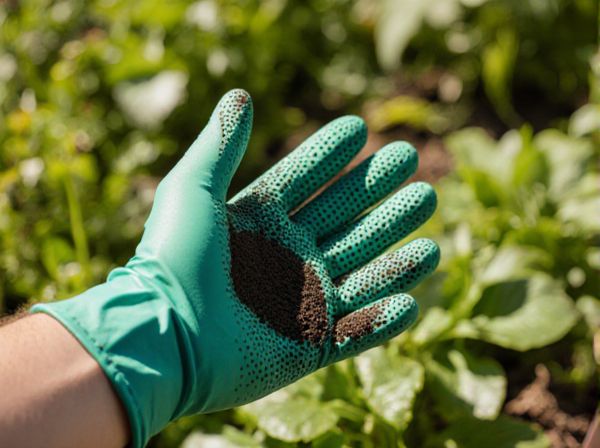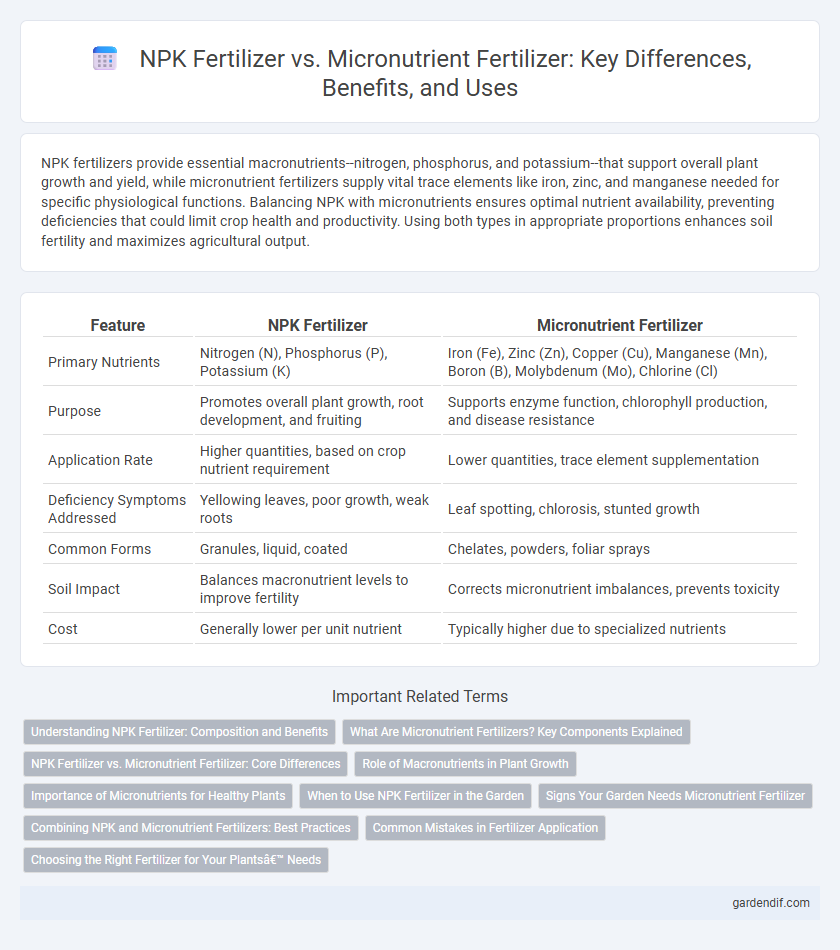
NPK fertilizer vs micronutrient fertilizer Illustration
NPK fertilizers provide essential macronutrients--nitrogen, phosphorus, and potassium--that support overall plant growth and yield, while micronutrient fertilizers supply vital trace elements like iron, zinc, and manganese needed for specific physiological functions. Balancing NPK with micronutrients ensures optimal nutrient availability, preventing deficiencies that could limit crop health and productivity. Using both types in appropriate proportions enhances soil fertility and maximizes agricultural output.
Table of Comparison
| Feature | NPK Fertilizer | Micronutrient Fertilizer |
|---|---|---|
| Primary Nutrients | Nitrogen (N), Phosphorus (P), Potassium (K) | Iron (Fe), Zinc (Zn), Copper (Cu), Manganese (Mn), Boron (B), Molybdenum (Mo), Chlorine (Cl) |
| Purpose | Promotes overall plant growth, root development, and fruiting | Supports enzyme function, chlorophyll production, and disease resistance |
| Application Rate | Higher quantities, based on crop nutrient requirement | Lower quantities, trace element supplementation |
| Deficiency Symptoms Addressed | Yellowing leaves, poor growth, weak roots | Leaf spotting, chlorosis, stunted growth |
| Common Forms | Granules, liquid, coated | Chelates, powders, foliar sprays |
| Soil Impact | Balances macronutrient levels to improve fertility | Corrects micronutrient imbalances, prevents toxicity |
| Cost | Generally lower per unit nutrient | Typically higher due to specialized nutrients |
Understanding NPK Fertilizer: Composition and Benefits
NPK fertilizer contains nitrogen (N), phosphorus (P), and potassium (K), essential macronutrients that support plant growth, root development, and overall crop yield. Unlike micronutrient fertilizers, which supply trace elements like iron, zinc, and manganese needed in smaller amounts, NPK fertilizers address the primary nutritional requirements of plants. Proper use of NPK fertilizer enhances soil fertility and promotes robust plant health by balancing these critical nutrients.
What Are Micronutrient Fertilizers? Key Components Explained
Micronutrient fertilizers contain essential trace elements like zinc, iron, manganese, copper, boron, molybdenum, and chlorine that are crucial for plant growth but required in smaller quantities than NPK nutrients. Unlike NPK fertilizers, which supply macronutrients nitrogen, phosphorus, and potassium for primary plant functions, micronutrient fertilizers support enzymatic activities, chlorophyll production, and overall metabolic processes. Proper use of micronutrient fertilizers prevents deficiencies that can lead to poor crop yields, making them vital complements to traditional NPK fertilization strategies.
NPK Fertilizer vs. Micronutrient Fertilizer: Core Differences
NPK fertilizers primarily provide macronutrients--nitrogen (N), phosphorus (P), and potassium (K)--essential for fundamental plant growth and high yield. Micronutrient fertilizers supply trace elements like zinc, iron, manganese, and copper, which are crucial for enzyme function and physiological processes in plants but required in much smaller amounts. The core difference lies in the nutrient concentration and the role each plays, with NPK fertilizers addressing broad nutritional deficiencies and micronutrient fertilizers targeting specific, often soil-limited, nutrient needs.
Role of Macronutrients in Plant Growth
Macronutrients such as nitrogen (N), phosphorus (P), and potassium (K) in NPK fertilizers are vital for plant growth, supporting essential functions like photosynthesis, energy transfer, and root development. Nitrogen promotes lush leaf and stem growth, phosphorus facilitates root and flower formation, and potassium enhances overall plant health and resistance to stress. While micronutrient fertilizers supply trace elements like iron, zinc, and manganese necessary for enzyme function, macronutrients form the primary building blocks for plant biomass and yield.
Importance of Micronutrients for Healthy Plants
NPK fertilizers supply essential macronutrients nitrogen, phosphorus, and potassium, which are vital for plant growth but do not cover micronutrients like iron, zinc, and manganese that are crucial for enzymatic functions and chlorophyll production. Micronutrient fertilizers address specific deficiencies that can impair photosynthesis, nutrient uptake, and disease resistance, ensuring balanced plant nutrition and optimal crop yield. Incorporating micronutrients alongside NPK fertilizers enhances soil fertility and supports sustainable agricultural productivity.
When to Use NPK Fertilizer in the Garden
NPK fertilizer is essential during the early stages of plant growth when nitrogen, phosphorus, and potassium are needed to promote strong root development, healthy foliage, and overall vigor. Use NPK fertilizer at planting time and during active vegetative growth to ensure plants receive balanced macronutrients for optimal yield. Micronutrient fertilizers are best applied later to correct specific nutrient deficiencies or during fruiting stages for improved quality and resilience.
Signs Your Garden Needs Micronutrient Fertilizer
Yellowing leaves with green veins and stunted plant growth often indicate a deficiency in essential micronutrients such as iron, manganese, or zinc, signaling the need for micronutrient fertilizer. Unlike NPK fertilizers that supply nitrogen, phosphorus, and potassium, micronutrient fertilizers address trace element imbalances crucial for enzyme function and chlorophyll production. Recognizing symptoms like leaf necrosis, poor flowering, or reduced fruit yield helps gardeners optimize plant health by supplementing with targeted micronutrients.
Combining NPK and Micronutrient Fertilizers: Best Practices
Combining NPK fertilizers with micronutrient fertilizers enhances plant growth by addressing both macronutrient and essential trace element deficiencies, optimizing nutrient availability and uptake. Best practices include soil testing to determine precise nutrient needs, applying NPK fertilizers in balanced ratios tailored to crop requirements, and supplementing with micronutrients such as iron, zinc, and manganese to prevent hidden hunger. Integrating these fertilizers through split applications and foliar feeding maximizes efficiency, improves crop yield, and supports sustainable soil health.
Common Mistakes in Fertilizer Application
Common mistakes in fertilizer application include over-reliance on NPK fertilizers while neglecting essential micronutrients such as zinc, iron, and manganese, leading to nutrient imbalances and reduced crop yields. Applying micronutrient fertilizers without proper soil testing can result in deficiencies or toxicities, harming plant health and soil quality. Accurate soil analysis and balanced nutrient management are critical to optimizing fertilizer efficiency and ensuring sustainable crop production.
Choosing the Right Fertilizer for Your Plants’ Needs
NPK fertilizers provide essential macronutrients--nitrogen, phosphorus, and potassium--crucial for overall plant growth, root development, and fruit production. Micronutrient fertilizers supply trace elements like iron, zinc, and manganese necessary for enzyme function and chlorophyll synthesis but are required in smaller quantities. Selecting the right fertilizer depends on soil testing results and specific plant nutritional requirements to ensure balanced nutrient availability and optimize crop yield.
NPK fertilizer vs micronutrient fertilizer Infographic

 gardendif.com
gardendif.com